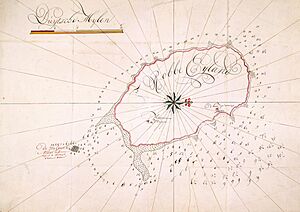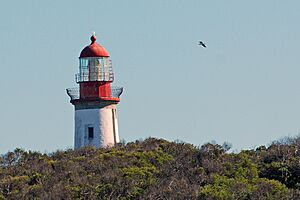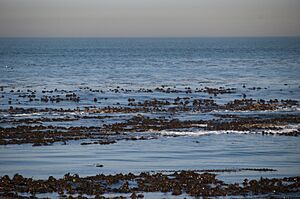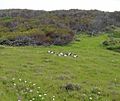Robben Island facts for kids
Quick facts for kids
Robben Island
Robbeneiland
|
|
|---|---|
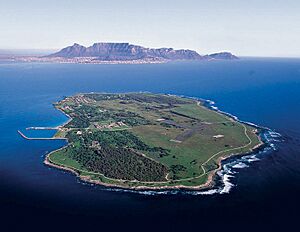
Robben Island viewed from above
|
|
| Country | South Africa |
| Province | Western Cape |
| Municipality | City of Cape Town |
| Area | |
| • Total | 5.18 km2 (2.00 sq mi) |
| Population
(2011)
|
|
| • Total | 116 |
| • Density | 22.39/km2 (58.00/sq mi) |
| Racial makeup (2011) | |
| • Black African | 60.3% |
| • Coloured | 23.3% |
| • White | 13.8% |
| • Other | 2.6% |
| First languages (2011) | |
| • Xhosa | 37.9% |
| • Afrikaans | 35.3% |
| • Zulu | 15.5% |
| • English | 7.8% |
| • Other | 3.4% |
| Time zone | UTC+2 (SAST) |
| PO box |
7400
|
| Type: | Cultural |
| Criteria: | III, VI |
| Designated: | 1999 (23rd session) |
| Reference #: | 916 |
| Region: | Africa |
Robben Island (which means Seal Island in Dutch) is a small island located in Table Bay, South Africa. It's about 6.9 kilometers (4.3 miles) west of the coast near Cape Town. The island is named after the many seals that used to live there.
The island is mostly flat and sits just a few meters above sea level. For a long time, from the late 1600s until 1996, it was used as a prison. This was especially true during apartheid, a time when South Africa had strict laws separating people by race.
One of the most famous prisoners on Robben Island was Nelson Mandela. He was held there for 18 of the 27 years he was imprisoned. After apartheid ended, he became the first black president of South Africa. Many other political prisoners were also held on Robben Island. Two other former prisoners, Kgalema Motlanthe and Jacob Zuma, also later became presidents of South Africa.
Today, Robben Island is a very important place. It is a South African National Heritage Site and a UNESCO World Heritage Site. This means it's recognized globally for its historical importance.
Contents
Island History
Robben Island is located at the entrance to Table Bay, about 11 kilometers (6.8 miles) from Cape Town. It was first found by Bartolomeu Dias in 1488. For many years, sailors from Portugal, England, and the Netherlands used it as a place to stop and resupply their ships.
In 1654, Dutch settlers brought sheep to the island. They built shelters for the animals and collected seal skins and oil. The island's isolation helped protect the animals from wild predators on the mainland.
Robben Island as a Prison
Since the late 1600s, Robben Island has been used as a prison, mostly for political prisoners. These were people jailed because of their beliefs or actions against the government. The first known prisoner was Autshumato in the mid-1600s. Other early prisoners included leaders from other Dutch colonies.
In 1819, after a failed uprising, the British government sent African leader Makanda Nxele to the island for life.
The island was also used as a place to keep people with leprosy (a serious skin disease) and animals in quarantine (isolated to prevent disease spread). In the late 1800s, many people with leprosy were moved to Robben Island. Doctors at the time believed that isolating them was the only way to stop the disease from spreading.
During World War II, the island was made stronger with large guns to help protect Cape Town.
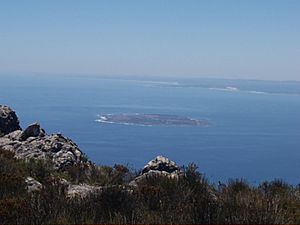
From 1961, the South African government used Robben Island as a high-security prison for political prisoners and criminals. In 1969, the Moturu Kramat was built. This is a special place for Muslims to visit and remember Sayed Abdurahman Moturu, an important Muslim leader who was exiled to the island in the 1740s. Muslim political prisoners would visit this shrine before leaving the island.
The maximum security prison for political prisoners closed in 1991. The prison for criminal prisoners closed five years later.
Robben Island Today
After apartheid ended, Robben Island became a popular place for tourists to visit. It is now managed by the Robben Island Museum. In 1999, it was named a World Heritage Site because of its important role in South Africa's journey to democracy.
Thousands of visitors take a ferry from Victoria & Alfred Waterfront in Cape Town to tour the island and its former prison. Many of the tour guides are former prisoners themselves, sharing their own experiences.
Visiting the Island
You can visit Robben Island by taking a tour from Cape Town's waterfront. Tours usually happen three times a day and last about 3.5 hours. This includes a ferry ride to and from the island and a tour of the important historical places.
These sites include the island graveyard, the old lime quarry, and the maximum security prison. You can even see Nelson Mandela's cell.
Dangers for Ships
Sailing near Robben Island and a nearby hidden rock called Whale Rock can be very dangerous for ships. Strong ocean waves and the island's rocky coastline can quickly break apart ships that hit the rocks. More than 30 ships are known to have been wrecked around the island.
In 1990, a team from the University of Cape Town searched the seabed around Robben Island. They found 24 sunken ships. Most of these wrecks were in shallow water. The team believed that bad weather, darkness, and fog were the main reasons for the shipwrecks.
Robben Island Lighthouse
Because of the dangers to ships, Jan van Riebeeck, the first Dutch leader in Cape Town, ordered large bonfires to be lit on the island's highest point at night. These fires warned ships that they were getting close to the island.
In 1865, the Robben Island lighthouse was built on Minto Hill. It is 18 meters (59 feet) tall. In 1938, the light was changed to electricity. The lighthouse flashes a bright white light every seven seconds, which can be seen up to 24 nautical miles (44 kilometers) away. A second red light helps guide ships sailing south.
Wildlife and Conservation

When the Dutch arrived in 1652, the main animals on the island were seals and birds, especially penguins. In 1654, settlers brought rabbits to the island so that passing ships would have a source of meat.
The original group of African penguins on the island disappeared by 1800. However, a new group started living there in 1983. Today, Robben Island is an important place for these penguins to breed. The number of penguins grew to about 16,000 in 2004, but it has been decreasing since then. By 2015, there were only about 3,000 penguins. This decline is happening at most African penguin colonies. It might be because there isn't enough food (like sardines and anchovies) due to fishing. Even with fewer penguins, they are still a popular sight for tourists.
In the early 2000s, the number of rabbits on the island grew to about 25,000. These rabbits became an invasive species, meaning they were harming the natural environment and other animals. To help the island's ecosystem, people are now working to reduce the rabbit population.
Images for kids
-
Ahmed Kathrada, who was imprisoned in Robben Island between 1964 and 1982, is pictured giving a tour of the prison to the then US President Barack Obama and his family in 2013.
-
Rock pile started by Nelson Mandela and added to—one rock at a time—by former prisoners returning to the island.
-
Muslim Moturu Kramat shrine on Robben Island.
-
World War II guard pillbox.
-
African sacred ibis on Robben Island, 2015.
See also
 In Spanish: Isla Robben para niños
In Spanish: Isla Robben para niños
- 1620 Robben Island earthquake
- List of World Heritage Sites in South Africa
- List of heritage sites near Cape Town




